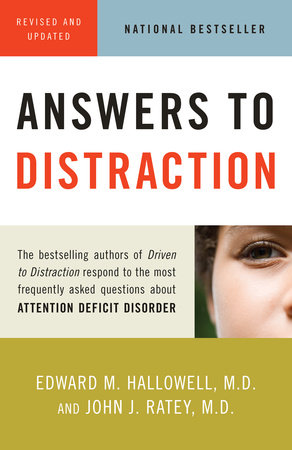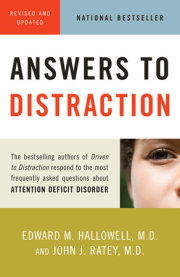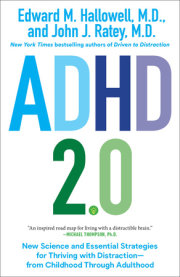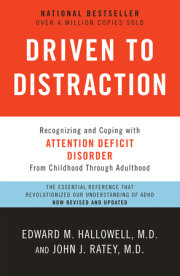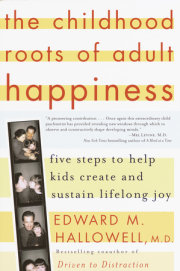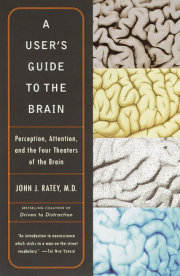1
You Mean There's Actually a Name for It?
Toward a Definition of ADD
Q: Can you tell me in brief what I need to know about ADD?
A: I can try. ADD is a neurological syndrome that is usually genetically transmitted. It is characterized by distractibility, impulsivity, and restlessness. In ADD these symptoms are present from childhood on, and with a much greater intensity than in the average person, so that they interfere with everyday functioning. Diagnosis is made primarily by reviewing one's history; there is no foolproof "test" for ADD. Great care must be taken to make an accurate diagnosis and to look for other problems that may occur along with ADD, such as low self-esteem, depression, substance abuse, or family turmoil.
Treatment includes education, structure, coaching, and medication. With treatment, the prognosis is usually good.
Both diagnosis and treatment should always be done under medical supervision. ADD is a tricky diagnosis and the treatment is not always simple. You should never diagnose or treat yourself.
Q: Are there any advantages to having ADD?
A: Yes. There are many.
To the extent that there is such a thing as the ADD personality--and I believe that there is--it has its pluses and its minuses. The pluses are not usually discussed much because books and articles about ADD naturally tend to focus on problems and solutions rather than advantages. But the advantages deserve prominent mention. They include:
• High energy
• Creativity
• Intuitiveness
• Resourcefulness
• Tenacity
• Hardworking, never-say-die approach
• Warmheartedness
• Trusting attitude (sometimes too much so)
• Forgiving attitude (sometimes too much so)
• Sensitivity (often can hurt as well as serve the person)
• Ability to take risks (again, a double-edged sword)
• Flexibility
• Good sense of humor
• Loyalty
Lest the skeptic think this sounds more like the Boy Scouts' oath than a legitimate list of traits, let me hasten to add that not all people with ADD have all these qualities, nor can I prove the scientific validity of the list itself. However, based upon my experience with thousands of individuals with ADD, and based upon my conversations with many other authorities in the field, this list of positive qualities does fairly describe the advantageous side of the ADD personality.
People with ADD do tend to be warm, creative, flexible, loyal, innovative, hardworking, and the rest of the qualities on that list. However, the problems their ADD causes can be so severe that these positive qualities never gain full expression or recognition. The negative qualities can be so toxic and self-defeating that the strengths are wasted.
Once the person gets proper treatment, the negative aspects of ADD recede, and the positive can flourish.
People with ADD remind me of the bumblebee. The bumblebee should not be able to fly. Its body is too big and its wings are too short. Scientists say it should not be able to fly. Aerodynamically, it should be impossible. The physicists agree--the design of the bumblebee is incompatible with flight. Its balance should be all off. So how does the bumblebee fly? We don't know. But it does fly. That much we do know.
Q: Is there a hallmark of ADD, a single core trait that defines it best?
A: In our opinion, yes there is. It is a relative lack of inhibition. People with ADD tend to be more spontaneous than the average person. They speak freely, at times too much so. They think freely, at times creatively, at other times chaotically. They act unpredictably: often even they do not know what they're going to do next. They do not inhibit their responses as stringently as most people do. They often lack the intermediate reflective step between impulse and action. This can be charming and innovative, or it can be annoying and disruptive, depending upon the impulse and the action.
People with ADD neither inhibit nor shape their responses as automatically as those who do not have ADD. This leads, directly or indirectly, to almost all of the other symptoms associated with ADD, including disruptive behavior, impulsivity, restlessness, uneven attention span, disorganization, tactlessness, irritability, impatience, and risk-taking behavior. It also leads to many of the positive qualities of ADD, such as creativity (because creativity depends upon some degree of disinhibition), spontaneity, high energy, and openness (people with ADD do not inhibit responses long enough to close down and become guarded). Most treatment aims to increase inhibition where needed, without imposing unwanted limits.
Q: What is the best definition of "attention deficit disorder"?
A: We do not know exactly what attention deficit disorder is. The most official definition is found in a volume entitled the Diagnostic and Statistical Manual of Mental Disorders, published by the American Psychiatric Association. The first edition of this manual was published in 1952. It has been updated several times since then. Its most recent incarnation, the fourth, was published in 1994. For short, it is called DSM-IV. Here is how DSM-IV defines ADD:
A. Either (1) or (2):
1. Six (or more) of the following symptoms of inattention have persisted for at least six months to a degree that is maladaptive and inconsistent with developmental level:
a. often fails to give close attention to details or makes careless mistakes in schoolwork, work, or other activities
b. often has difficulty sustaining attention in tasks or play activities
c. often does not seem to listen when spoken to directly
d. often does not follow through on instructions and fails to finish schoolwork, chores, or duties in the workplace (not due to oppositional behavior or failure to understand instructions)
e. often has difficulty organizing tasks and activities
f. often avoids, dislikes, or is reluctant to engage in tasks that require sustained mental effort (such as schoolwork or homework)
g. often loses things necessary for tasks or activities
h. is often easily distracted by extraneous stimuli
i. is often forgetful in daily activities
2. Six (or more) of the following symptoms of hyperactivity (a to f)-impulsivity (g to i) have persisted for at least six months to a degree that is maladaptive and inconsistent with developmental level:
a. often fidgets with hands or feet or squirms in seat
b. often leaves seat in classroom or in other situations in which remaining seated is expected
c. often runs about or climbs excessively in situations in which it is inappropriate (in adolescents or adults, may be limited to subjective feelings of restlessness)
d. often has difficulty playing or engaging in leisure activities quietly
e. is often "on the go" or often acts as if "driven by a motor"
f. often talks excessively
g. often blurts out answers before questions have been completed
h. often has difficulty awaiting turn
i. often interrupts or intrudes on others (e.g., butts into conversations or games)
B. Some hyperactive-impulsive symptoms that caused impairment were present before age seven years.
C. Some impairment from the symptoms is present in two or more settings (e.g., at school [or work] and at home).
D. There must be clear evidence of clinically significant impairment in social, academic, or occupational functioning.
Copyright © 1996 by Edward M. Hallowell, M.D. and John J. Ratley, M.D.. All rights reserved. No part of this excerpt may be reproduced or reprinted without permission in writing from the publisher.

